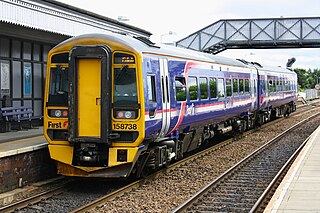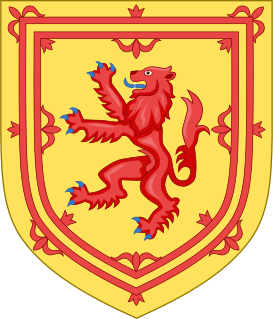Related Research Articles

First ScotRail was a train operating company in Scotland owned by FirstGroup which operated the ScotRail franchise from October 2004 until March 2015. Prior to October 2004, trains were run by ScotRail. First ScotRail was succeeded by Abellio ScotRail on 1 April 2015.

Local government in Scotland comprises thirty-two local authorities, commonly referred to as Scottish councils. Each council provides public services, including education, social care, waste management, libraries and planning. Councils receive the majority of their funding from the Scottish Government, but operate independently and are accountable to their local electorates. Councils raise additional income via the Council Tax, a locally variable domestic property tax, and Business rates, a non-domestic property tax.
The lieutenancy areas of Scotland are the areas used for the ceremonial lord-lieutenants, the monarch's representatives, in Scotland. The lord-lieutenants' titles chosen by the monarch and her legal advisers are mainly based on placenames of the traditional counties of Scotland. In 1794 permanent lieutenancies were established by Royal Warrant. By the Militia Act 1797, the lieutenants appointed "for the Counties, Stewartries, Cities, and Places" were given powers to raise and command County Militia Units.
The Local Government etc. (Scotland) Act 1994 is an Act of the Parliament of the United Kingdom which created the current local government structure of 32 unitary authorities covering the whole of Scotland.
The local government areas of Scotland were redefined by the Local Government (Scotland) Act 1973 and redefined again by the Local Government etc (Scotland) Act 1994.
The transport system in Scotland is generally well-developed. The Scottish Parliament has control over most elements of transport policy within Scotland, with the Cabinet Secretary for Transport, Infrastructure and Connectivity holding portfolio responsibility within the Scottish Government. Transport Scotland is the Executive Agency responsible for the Scottish transport network.

Dundee railway station serves the city of Dundee on the east coast of Scotland. The station has two through platforms and two terminal platforms. It is situated on the northern, non-electrified section of the East Coast Main Line, 59+1⁄4 miles (95.4 km) northeast of Edinburgh. Dundee is the tenth busiest station in Scotland. In January 2014, the former main station building was demolished to make way for a new building as part of the Dundee Waterfront Project which opened on 9 July 2018.

Edinburgh is a major transport hub in east central Scotland and is at the centre of a multi-modal transport network with road, rail and air communications connecting the city with the rest of Scotland and internationally.

A house in multiple occupation (HMO), or a house of multiple occupancy, is a British English term which refers to residential properties where ‘common areas’ exist and are shared by more than one household.

Golf Street railway station is located on Golf Street in Carnoustie, Angus, Scotland, and serves the town's central areas. The station opened in 1960 as Golf Street Halt before changing its name on 16 May 1983.

A development plan sets out a local authority's policies and proposals for land use in their area. The term is usually used in the United Kingdom. A Local Plan is one type of development plan. The development plan guides and shapes day-to-day decisions as to whether or not planning permission should be granted, under the system known as development control. In order to ensure that these decisions are rational and consistent, they must be considered against the development plan adopted by the authority, after public consultation and having proper regard for other material factors.

STV is a Scottish free-to-air television channel owned by STV Group and is a part of the ITV network.
A county of city was a type of local government area in Scotland between 1893 and 1975. There were four of these areas, covering the cities of Aberdeen, Dundee, Edinburgh and Glasgow. Each area was governed by a city corporation and was administered independently of the surrounding county. The areas were abolished by the Local Government (Scotland) Act 1973, and were replaced by regions and districts in 1975.
The ancient university governance structure in Scotland is the organisational system imposed by a series of Acts of Parliament called the Universities (Scotland) Acts 1858 to 1966. The Acts applied to what were termed the 'older universities': the University of St Andrews, the University of Glasgow, the University of Aberdeen and the University of Edinburgh. Together these four universities are commonly referred to as the ancient universities of Scotland. Whilst the Acts do not directly apply to the University of Dundee, the same governance structure was ordained for use by that institution in its Royal charter.
The Scottish North Eastern Railway was a railway company in Scotland operating a main line from Perth to Aberdeen, with branches to Kirriemuir, Brechin and Montrose. It was created when the Aberdeen Railway amalgamated with the Scottish Midland Junction Railway on 29 July 1856. It did not remain independent for long, for it was itself absorbed by the Caledonian Railway on 10 August 1866.
Scouting in Scotland is largely represented by Scouts Scotland, a registered Scottish Charity No. SC017511 that is affiliated to the Scout Association of the United Kingdom. The Baden-Powell Scouts' Association also has a presence in Scotland.
The Planning etc. (Scotland) Act 2006 is an Act of the Scottish Parliament, one effect of which was the creation of four Strategic Development Planning Authorities. These bodies each comprise several local planning authorities and are charged with producing long-term development plans for the following city-regions
The politics of Glasgow, Scotland's largest city by population, are expressed in the deliberations and decisions of Glasgow City Council, in elections to the council, the Scottish Parliament and the UK Parliament.
References
- ↑ By Scottish Ministers through Designation Orders in June 2008 (Scottish Statutory Instruments 2008 No. 195 (Glasgow), 196 (Aberdeen), 197 (Dundee) and 198 (Edinburgh))
- ↑ The boundaries are set out in Circular 3/08: Strategic Development Plan Areas
- ↑ The Town and Country Planning (Development Planning)(Scotland) Regulations 2008
- ↑ Circular 1/09: Development Planning